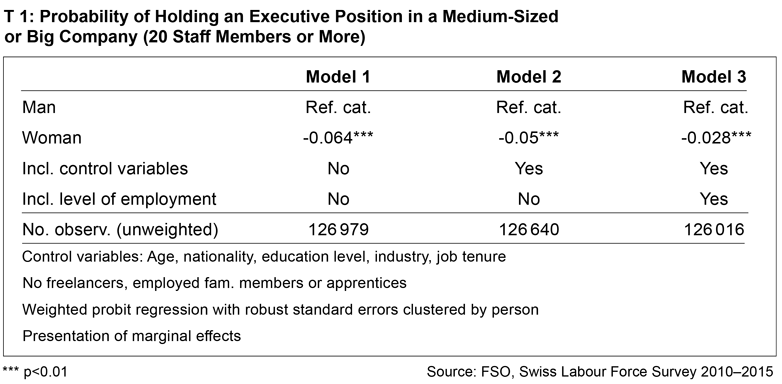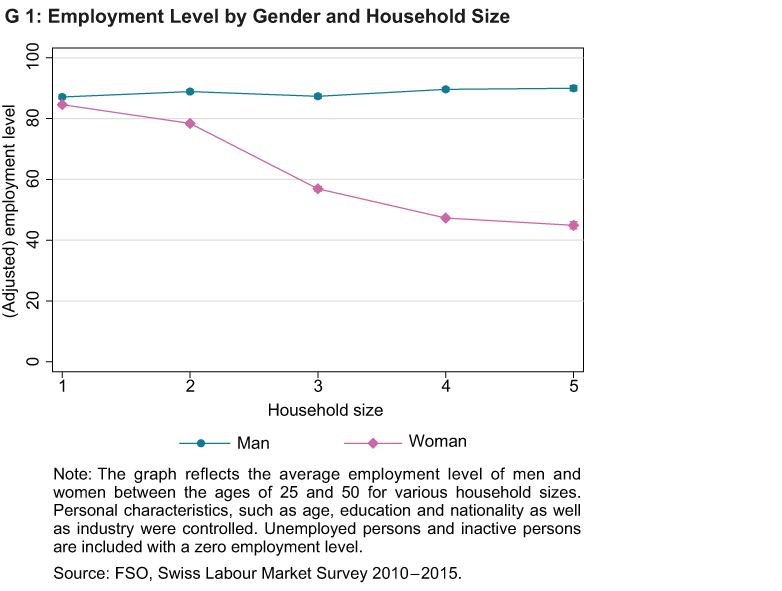Does Part-Time Work Increase Gender Inequality on the Labour Market?
- Labour Market
- KOF Bulletin
Although the prevalence of part-time work among women facilitates their integration into the labour market, it also has its downsides. Part-time work represents a career barrier, cementing inequality between the sexes. Childcare is the main reason why women opt for part-time work. A larger range of childcare facilities and more part-time executive positions for women and men would mitigate the problem.

Part-time work prevalent among women
In the period from 1970 to 2016, the proportion of employees working on a part-time basis rose from 12 per cent to 35 per cent. The trend towards part-time work in Switzerland applies both to women and to men, although the differences in levels are enormous: male part-time employees account for 16 per cent, female part-timers for 57 per cent. The Netherlands are the only OECD (Organisation for Economic Cooperation and Development) country with a higher percentage of women in part-time employment. Where men are concerned, Switzerland is just above the OECD average.
Part-time work as career barrier
Generally, the trend towards part-time work is seen as a positive development since it promotes compatibility of family and career, and contributes towards the integration of women into the labour market. Part-time work can, however, also have negative effects. Where executive positions are linked to full-time jobs, it can be a career obstacle. A descriptive evaluation of the Swiss Labour Force Survey (SAKE) supports this assumption: 87 per cent of executives in medium-sized and big companies hold full-time positions. As few as two per cent work at employment levels below 50 per cent. The same is true for management positions below the executive level. The data also show that women are significantly underrepresented in executive positions. This begs the question to what degree part-time work explains their underrepresentation.
Part-time work entrenches gender inequality
To answer the question, the researchers prepared an estimate of the impact gender has on the probability of holding an executive position (Table T 1). On average, 11.6 per cent of men and 5.2 per cent of women are members of the company management. The difference amounts to 6.4 percentage points (Model 1). Where comparative analysis is carried out between women and men of the same age, level of education, nationality and job tenure, in the same industry, the average difference is five percentage points (Model 2). A portion of the original difference is thus explained by the above characteristics. Once the level of employment is added as a further variable, the disadvantage suffered by women is reduced by a further 2.2 percentage points down to 2.8 (Model 3). Hence, one-third of women’s underrepresentation in executive jobs is explained by their high proportion in part-time employment.
Childcare is main reason for part-time employment
Why do so many women work part-time? In the SAKE survey, one-third of the women state that childcare is their main reason, while a further 16 per cent state other family-related reasons. Graph 1, which shows the average employment level by gender and household size, presents the relevance of childcare to the prevalence of part-time work among women in the comparison of employees of the same age, education level and nationality in the same industry. The employment level of men is not affected, or even positively affected, by the presence of further household members. In contrast, the employment level of women, which starts off the same as men, declines from 85 per cent in single households to 45 per cent in households with five members.
Lack of (affordable) childcare facilities
The fact that women, in particular, reduce their working hours when they have children is associated with traditional role models. However, as long as women continue to earn less than men, this decision also makes sense at the financial level. Many women among the SAKE respondents state that it is the lack of (affordable) childcare that forces them to withdraw from the labour market to look after the children. In comparison to other countries, there is room for improvement in Switzerland. Since the public sector’s contributions to childcare costs are below-average, families in Switzerland pay a higher than average share of the costs.
Conclusions
A number of conditions must be met to guarantee that people have real choices in terms of their employment level. Employees in full-time positions must be able to achieve a good work-life balance, which depends on the public sector providing an affordable and comprehensive childcare infrastructure. Furthermore, the bias against part-time employees that keeps them from holding executive positions must be removed. Part-time positions should become commonplace at all management levels – both for women and men. The classic division of roles where household and childcare responsibilities are concerned must be challenged if gender equality is to improve.
This article ist based on Download KOF Analysen, 2017, Nr. 2, Spezialanalyse: Verstärkt Teilzeitarbeit die Geschlechterungleichheit auf dem Arbeitsmarkt? (PDF, 384 KB) by Daniel Kopp.
Contact
KOF Konjunkturforschungsstelle
Leonhardstrasse 21
8092
Zürich
Switzerland

